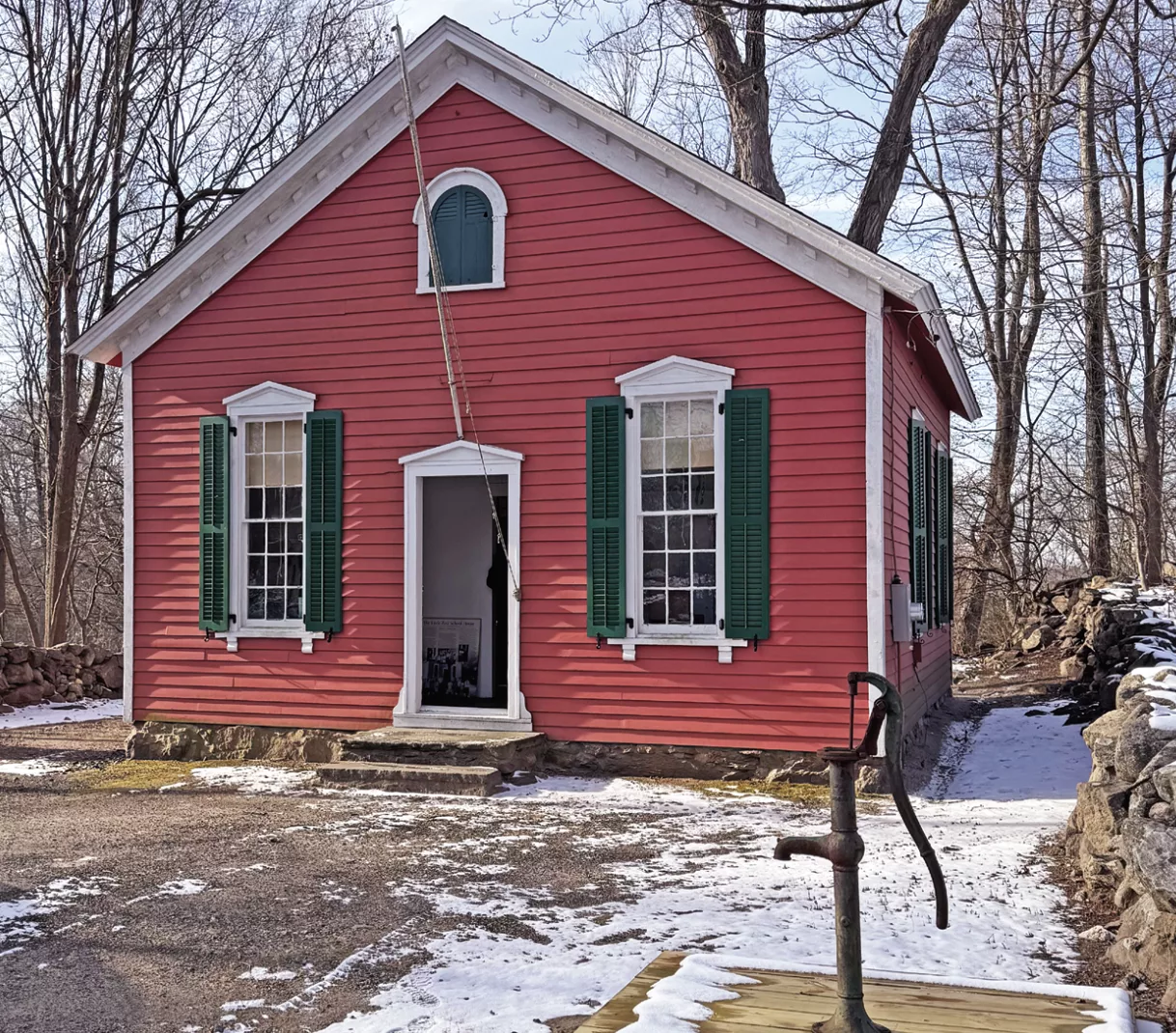
By John Kriz
Resting quietly near the north end of Carter Street, close to the New Canaan Mounted Troop horse barn, is the Little Red Schoolhouse, which was the last operating one room schoolhouse in New Canaan, and one of the last in Connecticut. Now owned and maintained by the New Canaan Museum & Historical Society (www.nchistory.org) the schoolhouse provides a welcome glimpse into educational history and local society.
According to Stephen Gravereaux, a student at the school from the mid-1940s to the early 1950s and a former board member of the Historical Society, whose family stretches back to the Hoyts, who settled in the area in the 1600s, “the original school building was a log cabin building that was dragged up Carter Street by a team of oxen from the corner of Carter and Silvermine Roads and Canoe Hill. I don’t think it had been a school before that, but it was a building that was turned into a school building on a third of an acre that my great great grandfather sold to the town for $50 in 1850 or thereabouts. And they dragged the school up and it lasted there for a few years, and they tore it down in 1855, I believe, and built a school similar to the one that’s there now. But that burned on February 21, 1864, — burned to the ground — and they rebuilt the school there that same year.”
Miss Kelley
The last teacher at the Little Red Schoolhouse was Mary Kelley, who taught there from 1910 to 1957. When Miss Kelley started teaching at the school it covered grades 1-8, but over time shrank to just the primary grades. Mr. Gravereaux notes that the town kept it open for her, and closed it when she retired. She had also been a pupil there, and lived a few doors down the road.
“She was the boss,” remembers Mr. Gravereaux. “We tended not to be bad. We knew what was right and what was wrong, and we tried not to cross Miss Kelley.” He goes on to say that “if there was something that was bad, your parents found out about it, too.” Corporal punishment was not unusual in those days, but it did not happen at this school, though Mr. Gravereaux notes that he’d gotten his knuckles rapped a couple of times.
What made attending the Little Red Schoolhouse special, according to Mr. Gravereaux, was “knowing the same teacher for all those years and her knowing us. I think that was the best thing. It was really the teacher that made it very special.” As to educational quality, he says he “got absolutely the best,” and when he went to South School for sixth grade “it was just a breeze. I had basically done all the work in math and history and it was just simple. The work was not difficult compared to what Miss Kelley pushed through. She had us work at our own pace basically, and she pushed us as far as we could go.” Continues Mr. Gravereaux, “Everybody loved her (Miss Kelley).” And the parents? “The parents especially. She worked very closely with the parents and you’d get her report cards and if parents wanted to discuss it, she’d readily be available.” His biggest educational challenge was riding his bike to school past “a house that had a big German Shepherd that just hated me.”
School Design
As you enter the Little Red Schoolhouse there are two open storage areas to the right and left for coats, books and equipment. Materials that students collected for science class, including birds’ nests and a turtle, are also displayed. In the middle of the classroom sits a cast iron potbelly stove, fueled by wood and coal — the sole heat source. In the late 1940s some of the children installed and painted a metal screen to go around the stove for safety as the stove was very hot. However, it could get cold in the room’s corners, Mr. Gravereaux notes. To help him cope with the cold, his grandmother, Mary Hoyt Hollingsworth, who was also a former pupil, would knit him “scratchy wool stockings that went up to the knees because she knew that my feet would get cold in the school.”
There were two overhead lights in the classroom area, plus a desk lamp for Miss Kelley, which was plugged in to the sole outlet. Behind the school were two outhouses. In front were bins to store wood and coal, and a manual water pump over a hand dug 22 foot deep well lined with stone. The desks and other items in the school are as they were left when the school closed.
The wonderful artwork that adorns the school’s walls are reproductions (the originals are housed at the Historical Society) of art created by Justin Gruelle, a Silvermine art colony artist, under the Works Progress Administration, a New Deal agency, during the 1930s. His brother John was the creator of Raggedy Ann and Andy dolls, as well as a writer and illustrator.
School Life
“We would arrive in the morning and come with our lunch pails or buckets or lunchboxes or bags, whatever, and we’d leave those on the front step,” recalls Mr. Gravereaux. “Miss Kelley would be inside in the colder weather having built a fire and making the school warm. And right at 8:30 she’d come out and she had a hand bell, which she would then ring. We’d all gather around, boys on one side and girls on the other side in a line, and we’d have one of the older boys put the flag up and then we’d say a pledge of allegiance. And then we’d march into school, taking our lunches with us and putting them on the shelf in one of the two little side rooms.”
The school’s children, which numbered up to thirty, had chores at the school. The older boys would ensure that the coal and wood bins were kept full, and the younger children would sweep the floors, empty the trash, wash the blackboards and clap the chalk dust off the erasers. The oldest children often ate lunch on “table rock,” a flat stone built into the stone wall at the border to the property. Some children would climb on the coal box and eat their lunch.
And there were games, which Miss Kelley was adept at inventing. Mr. Gravereaux recalls one being a type of hide and seek. Another was called Puff Ball, which consisted of two groups on either side of the long metal stove flue tossing a light cotton ball over the flue. If you hit the ceiling you were out, and if you hit the flue you were dusted with soot, and were also out. Mr. Gravereaux also recalls Miss Kelley playing Sousa marches on the Victrola, and the children would march around the school, up and down the rows of desks. Sometimes for posture Miss Kelley would make them put a book on their heads so they’d stand up straight. There was also kickball, and all sorts of word games such as ‘Refrigerator Door,’ when a child would say he or she found asparagus, and the next child butter — A, B, C. You had to continue down the alphabet, repeating the prior ones.
During Christmas there was a tree in the corner. The children would make chains out of paper for decoration and hang tinsel.
School life today is much different, but also the same. The one room schools that used to populate New Canaan are gone, but the focus on top quality education remains. Says Matt Wexler, a current New Canaan Board of Education member, “At its core it’s still about giving our children the very best education, and passing along the values of our town.”
The Little Red Schoolhouse holds periodic open houses. It is also open by appointment. For more information on the school, a booklet compiled by Robert W.P. Cutler M.D. entitled “Mary J. Kelley and the Little Red Schoolhouse: Student Recollections” is available at the Historical Society’s office.
Other One Room Schools
There used to be tens of thousands of one room schools in the country, but virtually all have closed. The few that remain are generally in small, isolated communities. However, many of the old school buildings still exist. Some are maintained by local charities (such as the Little Red Schoolhouse) whereas others have been repurposed.
Other one room schoolhouses in the area include:
• The Rock School on the New Canaan Museum and Historical Society campus. It was originally sited near Laurel Road and Canoe Hill as the First District School, and opened in 1799. In the 1970s the school building was in danger of being demolished, and New Canaan High School’s AP History class led a campaign to save it, raising money and generating community support to move and restore it for all to enjoy.
• The Peter Parley Schoolhouse, built in the mid-1800s at the corner of West Lane and South Salem Road (CT35) in Ridgefield.
• The circa 1872 Branchville Schoolhouse, in the Branchville section of Ridgefield. Listed on the Connecticut State Register of Historic Places, it is under renovation.
• The circa 1789 red brick Umpawaug Schoolhouse in Redding.
• The 1834 Hurlbutt Street School in the Cannondale section of Wilton. It is on the National Register of Historic Places.
• The Stone Jug Schoolhouse, on the Bedford Green in Bedford NY, built in 1829.
• In Stamford and Greenwich, several of these school buildings have been incorporated into residences, or are used by civic or religious groups. One such near New Canaan – the North Stamford School – was moved across Cascade Road and it is now the Guild House of the North Stamford Congregational Church.
Wisdom is the principal thing; therefore get wisdom: and with all thy getting get understanding.
Proverbs 4:7
John J Kriz is a 30+ year resident of New Canaan. The opinions expressed are his own.

